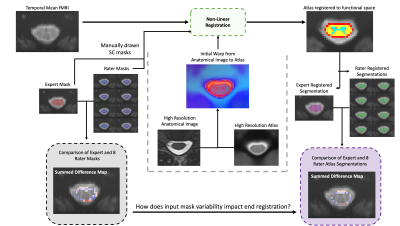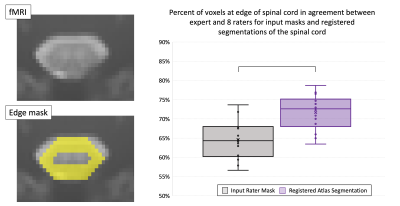Mark A Hoggarth1, Max C Wang2, Kimberly J Hemmerling1,2, Zachary A Smith3, Kenneth A Weber II4, and Molly G Bright1,2
1Physical Therapy and Human Movement Sciences, Northwestern University, Chicago, IL, United States, 2Biomedical Engineering, Northwestern University, Evanston, IL, United States, 3Neurosurgery, Oklahoma University, Oklahoma City, OK, United States, 4Anesthesiology, Perioperative and Pain Medicine, Stanford University, Palo Alto, CA, United States
1Physical Therapy and Human Movement Sciences, Northwestern University, Chicago, IL, United States, 2Biomedical Engineering, Northwestern University, Evanston, IL, United States, 3Neurosurgery, Oklahoma University, Oklahoma City, OK, United States, 4Anesthesiology, Perioperative and Pain Medicine, Stanford University, Palo Alto, CA, United States
Performing
non-linear registration of fMRI improved DSC and agreement at the edges
of the spinal cord between an expert rater and 8 raters with varied
levels of experience.

Outline
of data processing, starting with temporal mean of fMRI time series,
manually drawn spinal cord masks and comparison; then non-linear registration
using the Spinal Cord Toolbox; then the post-registration segmentations
and comparison.

Illustration
of edge masks and box plots of percent of voxels in agreement along the
edges in input masks and registered segmentations across all raters and
participants. Edge masks were created by a 2-pixel erosion subtracted
from 2-pixel dilation of the expert mask. Bar in box plot equates
significance (p < 0.01).
